The 14.5 GHz ECR4 source supplied to CERN in the
framework of the Heavy Ion Facility collaboration provided Pb27+
operational beams to a new custom built linac in 1994. This source,
which operates in the pulsed "afterglow" mode, quickly
met its design specification of 80 emA
and now provides currents >100 emA
regularly. Early source tests showed the existence of extremely
stable modes of operation. In the search for higher intensities
a number of experiments have been performed on plasma gas composition,
RF power matching, extraction, beam pulse compression and a biased
dynode. The results of these tests will be presented along with
further ideas to improve source performance.
CERN's original proton linac was shut down in 1992 after a final light ion period with sulphur ions. It was dismantled and construction started, on the site, of a new heavy ion linac (Linac3) intended for the acceleration of lead ions. This machine was built by an international collaboration involving GANIL, Caen (ion source); INFN, Legnaro (low energy beam transport and RFQ); GSI, Darmstadt (Interdigital-H linac and some RF systems); INFN, Torino (high energy transport and filtering); IAP, Frankfurt (debuncher), and CERN and assistance from Sweden, Switzerland, the Czech Republic, India. In June 1994 the first beam was passed to the next accelerator in the injector chain, (the booster synchrotron) and in October beam was given to the physics experiments for a nine week operational period.
An ECR (Electron Cyclotron Resonance) ion source was chosen for the project. Although the ECR was originally developed for continuous operation, the afterglow phenomenon can be exploited to give short pulses suitable for synchrotron operation of high charge state ions [1]. In the optimisation of the design of the new facility the output energy of the linac was defined to be 4.2 MeV/u for Pb53+, a charge state that is beyond the reach of normal ECR sources. Thus stripping at the end of the linac was necessary. Further design optimisations indicated that at least 80 emA of Pb25+ would be required from the source.
GANIL performed tests on their ECR4 (Fig. 1) source
and showed that enhanced intensities of highly charge lead ions
could indeed be obtained at 2.5 keV/u (approximately 20 kV total)
in the afterglow mode of operation which satisfied the criteria
of:- a) intensity >80 emA;
b) adequate useful beam length; c) pulse to pulse stability; d)
emittance. In fact, to limit the X-ray emission from the linac
cavities which were designed for 25+, the charge state 27+ was
chosen for operational purposes whilst still meeting the intensity
criterion.
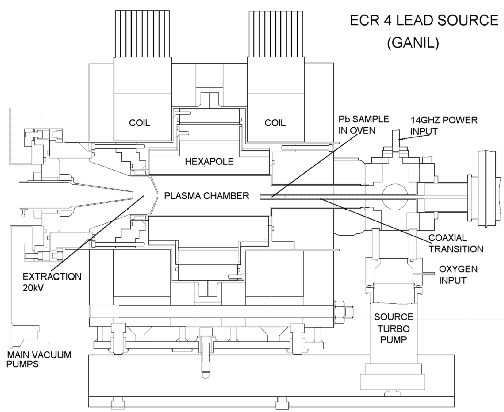
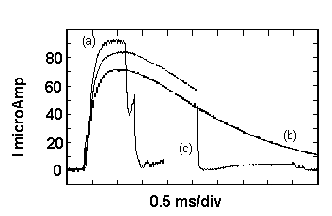
After commissioning of the source at CERN using the
GANIL test settings, 65 emA
of Pb27+ was measured in a Faraday cup after analyser
magnets. Improvements to the vacuum of the beam line and an extensive
optimisation of the source showed that about 100 emA
could be obtained (Fig. 2(a)). During a search
of the source parameter space, a new operating point was found.
At lower magnetic fields, the afterglow pulse became very smooth
and stable with a decay tail of several milliseconds (Fig. 2(b)).
The pulse rise time was of the order of 500 ms
and the plateau acceptable Although the intensities were somewhat
lower than the GANIL mode, a compromise could be found which retained
the extreme stability on a pulse to pulse basis whilst keeping
a good plateau (Fig. 2(c)). This stability proved to be invaluable
in the setting up of the following accelerators [2]. A reproducible
operating current of around 80 emA
was adopted as standard during the first (1994) physics run.
Initially an extraction gap of 42 mm was used in the source. Various tests have been carried out to investigate the optimum gap. In each case the source, and beam transport, was optimised for maximum intensity and stability of the beam. The results of these tests are summarised in figure 3. During the 1995 physics run the 47 mm gap, with 120 emA of Pb27+, was retained. Further tests on the gap are needed for other extracted currents and charge states.
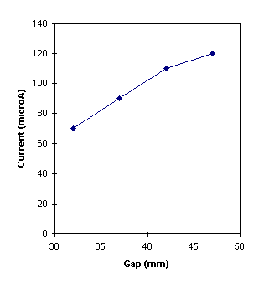
It had been suggested [3] that the replacement of oxygen as the pilot gas by neon should give rise to an improved intensity and an increase in the mean charge state. Extensive tests showed that the current of Pb27+ could not be increased using neon. Currents approaching those obtained with Pb/O2 operation could be reached, however the stability and duration of the afterglow pulse were reduced.
After a long period of operation with pure neon it became evident that at least a small amount of oxygen is required for Pb/Ne operation: after approximatly 24h it was not possible to start the discharge at the pressure required for high charge state production.
A significant difference between Pb/O2 and Pb/Ne operation was found when the source parameters were optimised on Pb30+ production (Fig. 4). In both cases the current of Pb30+ was 70µA. The maximum of the CSD was increased to 29+ for neon operation, while it remained at 27+ for oxygen. Initially a similar result was found for an optimisation on the Pb32+ peak. The maximum of the CSD was moved to Pb30+ for Pb/Ne and to Pb29+ for Pb/O2 operation. However, after a period of four weeks of operation with oxygen it could be shown that the maximum of the CSD can be shifted to 31+ for Pb/O2 operation (discharge optimised for 32+). The Pb32+ current was 80µA in this case while the best result for Pb/Ne was 50µA.
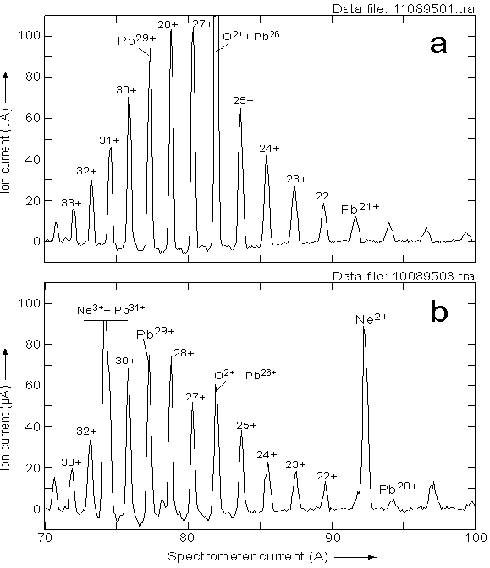
Microwave power is injected into the source via a tuned waveguide to co-axial transition. To obtain the best output and stability from the source, the optimum tuning of the transition was not necessarily that which gave the minimum reflected power. Additionally, other tuning points could be found which either gave similar, or reduced, performance within the range of the tuner. Certain operating points also gave rise to increased X-ray emission from the source.
Fig. 5 shows a comparison of the current during the afterglow with the current during the main pulse for the full tuning range. In a first approximation the two curves are complementary, i.e. if a high afterglow peak is obtained the current is low during the heating phase and vice versa. This is especially pronounced at position 4920 in Fig. 5. The maximum for the afterglow is found at position 4968, although the base current also goes through a maximum at this position.
It should be noted that the shape and duration of
the afterglow are also a function of the tuner position, so that
a peak on Fig. 5 does not necessarily indicate a stable operating
point. Furthermore the curve is influenced by the various source
parameters and it changes with time, so that an optimisation is
required at regular intervals.
The inner conductor of the co-axial transition which contains the sample oven and which penetrates into the plasma chamber (see Fig. 1) is known as the dynode. In another ECRIS for sulphur ions, the presence of a biased electrode in the plasma gave improved performance and stabilised the afterglow [4]. It had been reported that biasing the dynode in an ECR4 source also enhanced the yield of ions [5]. The original lead source dynode was a 6/8 mm copper tube but became a 10/8 mm tube in a biased configuration. Initial tests showed that it was impossible to control the source output using the oven heating as a parameter. The oven temperature is influenced by RF losses on the dynode, RF heating of the oven and resistive heating. There were indications that the lead neutral pressure in the source was too high and examination of the sample showed that it had been overheated, giving rise to a too high lead vapour pressure in the plasma chamber.
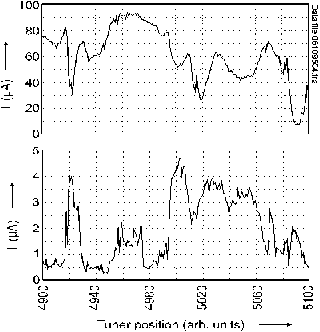
The dynode bore was reduced to 6 mm, as in the original electrode, and a much improved control of the oven was obtained. The source was optimised with zero bias, new RF tuning points and magnetic fields had to be found. It was immediately obvious that the source was much more temperamental and that all parameters had a very much reduced tolerance. The optimum RF tuning was now very sharp and just off the limit of stability. Satellite tuning points whilst more stable gave only 50% of the peak intensity.
Although it proved possible to optimise the source under these conditions, no gain in Pb27+ current was observed. Application of a negative bias to the dynode resulted in a loss of current, an increase in instability and beam breakup and a change in beam shape when the bias exceeded 50 V. These instabilities were also present in the microwave reflected power. As the bias increased above 200 V, the current appeared to climb again but isolation and sparking limited the bias that could be used reliably. Positive bias reduced the beam dramatically. However, it did prove possible to find a low magnetic field setting which reduced instabilities but without an improvement in intensity.
It was noted that for O2+, the current
in the afterglow, which is not very pronounced relative to that
in the main discharge, tended to decrease whilst the main discharge
current increased. It may be asked if the bias was insufficient
relative to the ionisation potential of Pb 27+ (874
eV).
Further tests are desirable (subject to operational
restrictions) to examine the effects of various ideas to increase
the yield of the Pb25+ and Pb27+ ions. Experiments
are only interested in particles not electrical intensity so an
increase in charge state from the source is not of interest unless
the intensity gain is dramatic. Going to lower charge states is
excluded in the linac design. Investigations that could be of
interest are:- extraction gap with current and ion species, continuation
of the biased electrode tests, plasma chamber wall materials,
sample composition and plasma gas effects.
[1] G.Melin, F. Bourg, P. Briand, J.Debernardi.M. Delaunay, R. Geller, B. Jacquot, P. Ludwig, T.K. N'Guyn, L. Pin, M. Pontonnier, J.C. Rocco and F. Zadworny, "Some Particular Aspects of the Physics of the ECR Source for Multicharged Ions", Proc. Int. Conf. On Ion Sources, Berkeley, 1989, Rev. Sci. Inst., 61, 236 (1990)
[2] H.D. Haseroth, "The CERN Heavy Ion Accelerating Facility", Proc 1995 Particle Accelerator Conference, Dallas, IEEE, V1, 411 (1996)
[3] G. Shirkov, "Improvement of Highly Charged Ion Production in the ECR Source of Heavy Ions", Proc. Int. Conf. On Ion Sources, Whistler, 1995, Rev. Sci. Inst., 67, 1158 (1996)
[4] P. Briand, R.Geller, H. Haseroth. C. Hill and K. Langbein, "Utilising the ECR Afterglow to Increase the Intensity of Highly Charged Ions in the CERN Accelerator Complex", Proc. 11th. Int. Workshop on ECR Ion Sources, Groningen, 1993, KVI Report 996, 132 (1993)
[5] P. Sortais, Private Communication